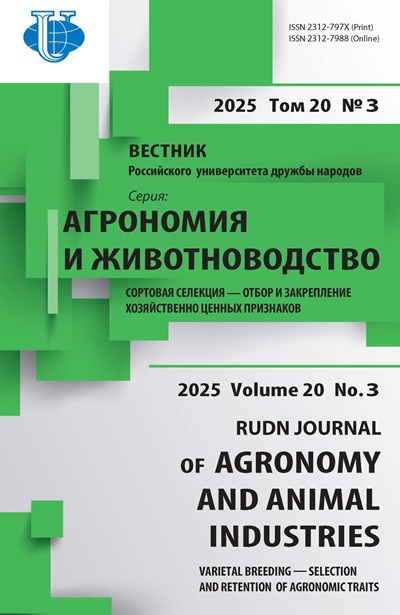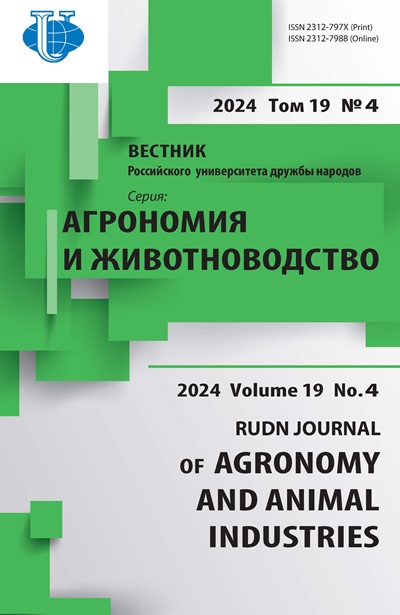Green mass of narrow-leaved lupine varieties as a source of soil fertility
- Authors: Lybenko E.S.1, Emelev S.A.1
-
Affiliations:
- Vyatka State Agrotechnological University
- Issue: Vol 19, No 4 (2024)
- Pages: 618-630
- Section: Soil science and agrochemistry
- URL: https://agrojournal.rudn.ru/agronomy/article/view/20128
- DOI: https://doi.org/10.22363/2312-797X-2024-19-4-618-630
- EDN: https://elibrary.ru/AXCRTL
- ID: 20128
Cite item
Full Text
Abstract
The maintenance and restoration of soil fertility is the basis for the stability of the country’s food security. One of the most effective methods of restorative agriculture is the use of siderates, the best of which are recognized plants of the legume family. The research was conducted at Vyatka State Agrotechnological University in 2022—2023 to study the possibility of using narrow-leaved lupine varieties of various breeding in regenerative agriculture. The soils of the experimental site are sod-medium podzolic medium loamy medium-rich in basic nutrients. The object of the study was narrow-leaved lupine varieties: Siderat 46, Akkord, Fedorovsky and Metsenat, the comparison was carried out with pea cv. Ukaz. The plots were 4.5 m2, four replications were used, the forecrop in both years was spring crops. All the studied varieties of lupin in agro-climatic conditions of Kirov region significantly exceeded the control in terms of yield of green mass of natural moisture. The yield increase was 50…60% with a slight coefficient of variation over the years in most varieties. The analysis of the yield of green mass considering its humidity showed that only Akkoord (16.40 t/ha) and Metsenat (15.95 t/ha) significantly exceeded the control (13.55 t/ha). The main part of lupine green mass obtained during harvesting is leaves (46.9%) and stems (43.9%). The variability over the years of these values is insignificant. Crude protein content and crude ash content of narrow-leaved lupine varieties were higher by 18…37% and 28…40%, respectively, compared to the control (pea). Metsenat variety had the highest crude protein and crude ash content per area unit — 2.7 and 1.31 t/ha, respectively. Narrow-leaved lupine varieties — Akkord, Fedorovsky and Metsenat — can be recommended for restorative agriculture in the north-east of Non-Chernozem zone of Russia to regenerate soil fertility.
Full Text
Meteorological conditions during the vegetation period of narrow-leaved lupine in 2022—2023
Source: compiled by E.S. Lybenko, S.A. Emelev in Microsoft Excel 2010.
Table 1
Green mass yield of natural moisture, t/ha
Variety | 2022 | ± to control | 2023 | ± to control | average | ± to control |
Ukaz (control) | 44.6 | – | 42.0 | – | 43.3 | – |
Siderat 46 | 61.9 | +17.3 | 66.3 | +24.3 | 64.1 | +20.8 |
Akkord | 82.8 | +38.2 | 58.7 | +16.7 | 70.7 | +27.4 |
Federovsky | 69.1 | +24.5 | 71.5 | +29.5 | 70.3 | +27.0 |
Metsenat | 72.4 | +27.8 | 67.6 | +25.6 | 70.0 | +26.7 |
LSD05 | – | 4.4 | – | 3.6 | – | 3.9 |
Source: compiled by E.S. Lybenko, S.A. Emelev in Microsoft Word 2010.
Table 2
Yield of absolutely dry green mass, t/ha
Variety | 2022 | ± to control | 2023 | ± to control | average | ± to control |
Ukaz (control) | 14.1 | – | 13.0 | – | 13.55 | – |
Siderat 46 | 12.5 | –1.6 | 11.6 | –1.4 | 12.05 | –1.5 |
Akkord | 17.1 | +3.0 | 15.7 | +2.7 | 16.40 | +2.9 |
Federovsky | 13.9 | –0.2 | 13.9 | +0.9 | 13.90 | +0.4 |
Metsenat | 13.6 | –0.5 | 18.3 | +5.3 | 15.95 | +2.4 |
LSD05 | – | 1.2 | – | 1.0 | – | 1.2 |
Source: compiled by E.S. Lybenko, S.A. Emelev in Microsoft Word 2010.
Table 3
Structure of green mass productivity at harvest time (average for 2022—2023)
Variety | Leaves, % | Vleaves, % | Seeds, % | Vseeds, % | Stems, % | Vstems, % |
Ukaz (control) | 22.5 ± 0.37 | 4.8 | 13.6 ± 0.44 | 9.4 | 63.9 ± 0.76 | 2.3 |
Siderat 46 | 46.7 ± 0.72* | 4.6 | 8.8 ± 0.39* | 11.2 | 44.5 ± 0.71* | 4.7 |
Akkord | 49.3 ± 0.63* | 3.7 | 7.5 ± 0.34* | 11.6 | 43.2 ± 0.81* | 5.6 |
Federovsky | 42.6 ± 0.42* | 3.9 | 9.3 ± 0.62* | 6.1 | 48.1 ± 0.51* | 2.9 |
Metsenat | 48.9 ± 0.74* | 7.2 | 11.2 ± 0.42* | 5.7 | 39.9 ± 0.47* | 4.9 |
Average | 46.9 ± 1.53* | 6.6 | 9.2 ± 0.77* | 16.7 | 43.9 ± 1.69* | 7.7 |
Note. * — р ≥ 0.95.
Source: compiled by E.S. Lybenko, S.A. Emelev in Microsoft Word 2010.
Table 4
Crude protein content and protein yield
Variety | Crude protein content, % | Protein yield, t/ha | ||||
2022 | 2023 | Average | 2022 | 2023 | Average | |
Ukaz (control) | 13.7 | 12.8 | 13.3 ± 0.45 | 1.90 | 1.70 | 1.80 ± 0.10 |
Siderat 46 | 16.6 | 15.4 | 16.0 ± 0.60* | 2.10 | 1.80 | 1.95 ± 0.15 |
Akkord | 17.0 | 14.5 | 15.8 ± 1.25* | 2.90 | 2.30 | 2.60 ± 0.30* |
Federovsky | 18.1 | 18.4 | 18.3 ± 0.15* | 2.50 | 2.60 | 2.55 ± 0.05* |
Metsenat | 17.7 | 16.4 | 17.1 ± 0.65* | 2.40 | 3.00 | 2.70 ± 0.30* |
Note. * — р ≥ 0.95.
Source: compiled by E.S. Lybenko, S.A. Emelev in Microsoft Word 2010.
Table 5
Raw ash content and yield
Variety | Raw ash content, % | Raw ash yield, t/ha | ||||
2022 | 2023 | Average | 2022 | 2023 | Average | |
Ukaz (control) | 6.3 | 5.5 | 5.9 ± 0.40 | 0.89 | 0.72 | 0.80 ± 0.09 |
Siderat 46 | 7.6 | 7.5 | 7.6 ± 0.05* | 0.92 | 0.88 | 0.90 ± 0.02 |
Akkord | 7.6 | 8.6 | 8.1 ± 0.50* | 1.30 | 1.35 | 1.32 ± 0.03* |
Federovsky | 7.3 | 8.0 | 7.7 ± 0.35* | 1.02 | 1.11 | 1.07 ± 0.05* |
Metsenat | 7.6 | 8.9 | 8.3 ± 0.65* | 0.99 | 1.63 | 1.31 ± 0.32* |
Note. * — р ≥ 0.95.
Source: compiled by E.S. Lybenko, S.A. Emelev in Microsoft Word 2010.
About the authors
Elena S. Lybenko
Vyatka State Agrotechnological University
Author for correspondence.
Email: elenalybenko@rambler.ru
ORCID iD: 0000-0001-8853-1903
SPIN-code: 3688-0476
Candidate of Agricultural Sciences, Associate Professor, Department of General Agriculture and Crop Production, Faculty of Agronomy
133 Oktyabrsky ave., Kirov, 610017, Russian FederationSergey A. Emelev
Vyatka State Agrotechnological University
Email: emeleffsergej@yandex.ru
ORCID iD: 0000-0003-4178-051X
SPIN-code: 4903-7819
Candidate of Agricultural Sciences, Associate Professor, Department of Plant Biology, Breeding and Seed Production, Microbiology
133 Oktyabrsky ave., Kirov, 610017, Russian FederationReferences
- Gogmachadze GD, Gogmachadze LG. On some results of agroecological monitoring of soils and land resources of the Russian Federation in 2019. AgrоEcоInfo. 2021;(4):17. (In Russ.). doi: 10.51419/20214410
- Minakov IA. Problems of land use for agricultural purposes. The Education and Science Journal. 2021;4(1):253. (In Russ.).
- Rostiashvili YR, Khachaturova EE. The role of the food problem in the global economy. Management Accounting. 2022;(3—3):661—667. (In Russ.). doi: 10.25806/uu3-32022650-660
- Abdusalamova RR, Balamirzoeva ZM. Soil degradation and its consequences. Bulletin of the Socio-pedagogical institute. 2022;(2):31—36. (In Russ.).
- Zhamalova DB. Features of the use of mineral fertilizers. In: Actual problems of the agro-industrial complex and innovative solutions: conference proceedings. Kurgan; 2021. р.43—47. (In Russ.).
- Shabanova IV. The effect of mineral fertilizers on the balance of heavy metals in the soil and grain of winter wheat. In: Results of research work for 2021: conference proceedings. Krasnodar; 2022. р.57—59. (In Russ.).
- Geisseler D, Scow KM. Long-term effects of mineral fertilizers on soil microorganisms — A review. Soil Biology and Biochemistry. 2014;75:54—63. doi: 10.1016/j.soilbio.2014.03.023
- Bai YC, Chang YY, Hussain M, Lu B, Zhang JP, Song XB, et al. Soil chemical and microbiological properties are changed by long-term chemical fertilizers that limit ecosystem functioning. Microorganisms. 2020;8(5):694. doi: 10.3390/microorganisms8050694
- Burdukovskii ML, Golov VI, Kovshik IG. Changes in the agrochemical properties of major arable soils in the south of the Far East of Russia under the impact of their long-term agricultural use. Eurasian soil science. 2016;49:1174—1179. doi: 10.1134/S1064229316100057
- Syrchina NV, Pilip LV, Ashikhmina TY. Chemical land degradation under the influence of animal husbandry waste. Theoretical and Applied Ecology. 2022;(3):219—225. (In Russ.). doi: 10.25750/1995-4301-2022-3-219-225
- Kokonov SI, Ryabova TN, Babaytseva TA, Yastrebova AV. Agrobiological evaluation of narrow-leaved lupin varieties in the conditions of the Middle Urals. IOP Conference Series: Earth and Environmental Science. 2022;949(1):012117. doi: 10.1088/1755-1315/949/1/012117
- Ageeva PA, Matyukhina MV, Pochutina NA, Gromova OM. Results and outlook of breeding of sideral narrow-leafed lupin varieties in the Russian lupin research institute. Legumes and groat crops. 2020;(2):59—63. doi: 10.24411/2309-348X‑2020-11170
- Hama JR, Strobel BW. Natural alkaloids from narrow-leaf and yellow lupins transfer to soil and soil solution in agricultural fields. Environmental Sciences Europe. 2020;32:126. doi: 10.1186/s12302-020-00405-7
- Mirakhmedov FS, Mirkhomidova NA, Mirkhomidova GM, Rakhimov AD, Kodirov AS. The extent of accumulation of biologically bound nitrogen by leguminous plants. Sovremennye tendentsii razvitiya nauki i tekhnologii. 2016;(12–1):129—131. (In Russ.).
- Katroschan KU, Stützel H. Narrow-leaved lupine as an N source alternative to grass-clover swards in organic vegetable rotations. Biological Agriculture & Horticulture. 2017;33(2):125—142. doi: 10.1080/01448765.2017.1285250
- Konnova LV, Ageeva PA. Lupin as an important biological potential of the south-west non-chernozem. Breeding and variety cultivation of fruit and berry crops. 2022;9(1):51—58. (In Russ.). doi: 10.24411/25000454_2022_0110
Supplementary files
Source: compiled by E.S. Lybenko, S.A. Emelev in Microsoft Excel 2010.
















